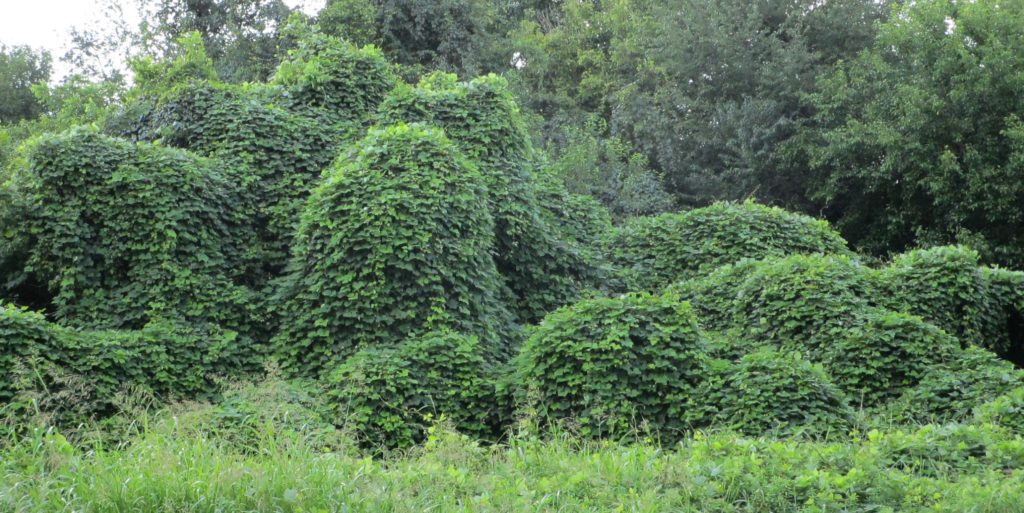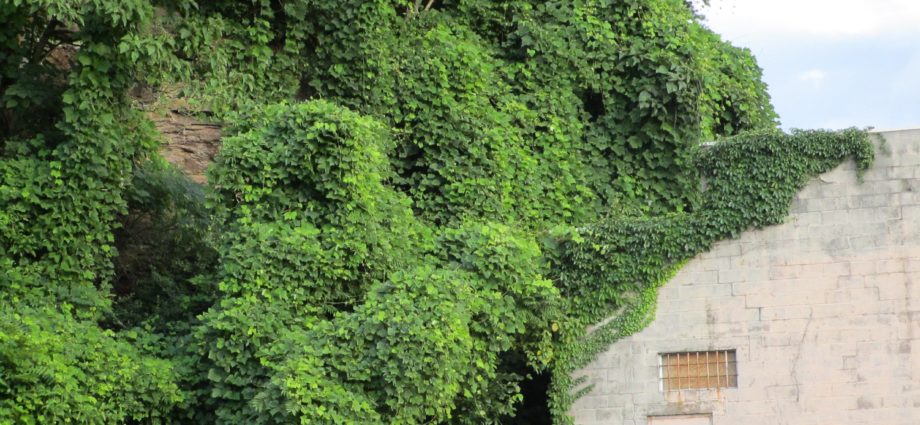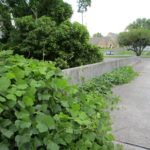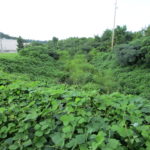On closer look
it becomes what we most
despise: something unnameably
near, confounding us with its
ability to make vague silhouettes
of familiar landmarks or
bloat the once-solid shapes
of signs lending geometric certitude
to all our directions.
— Edward Francisco
From “The Terror of Kudzu”
One of my favorite pastimes as a child was watching old scary movies with my mom – more of the suspense type with something a little on the literary or psychologically twisted side. In other words, we preferred a little Vincent Price, a little Edgar Allan Poe, with a few monsters and a paranormal smidgen of ghouls or demons.
Because I grew up in an Appalachian holler, I was captivated by nature horror. And the films that drew my attention and caused the most bewilderment were those involving malevolent plants. These scary movies caused me to imagine some chilling encounter in every woodland adventure. Each twig snap made my heart pound with horror-laden adrenaline. I looked to my left. Chigger plants housed an itchy enemy. I moved forward. Briers clutched with their prickly, crooked hands. I made it home. Cockle-burs hitchhiked and latched on like a body snatcher. But my most formidable adversary continues to be the evil, wicked vine. Several of these guilty foes still find their sprawling homes in Appalachia: poison ivy, poison oak, poison sumac, Virginia creeper, grapevines, and, of course, kudzu.

I recall a few horror movies my mother and I watched where creeping vines accosted an unknowing world. The 1965 horror anthology, Dr. Terror’s House of Horrors had such a story in the segment, “Creeping Vine,” where the Rogers family encounters an unknown trailing plant with a mind of its own (literally, it has a brain). The vine grows exponentially day by day and cannot be killed but does itself kill. In a 1982 horror anthology, Creepshow, the segment, “The Lonesome Death of Jordy Verrill,” offers a more harrowing picture of a creeping plant. Author Stephen King is cast as main character and country bumpkin, Jordy Verrill. Verrill discovers what he thinks is a meteor and imagines the rock has value. Once he touches it, the rock injures his fingers, and subsequently breaks apart, spewing a neon, green liquid. The wound he sustains on his fingers grows aggressively into a plant-like substance. Anything he touches follows suit. The camera pans outdoors and the audience sees a vine has quickly encompassed Verrill’s land, house, and everything in between. When the scene returns to Jordy Verrill, the audience comprehends his fate with horror – he nearabout becomes a full-fledged plant but he puts an end to it.
Whether or not that meteor was an extra-terrestrial meant nothing to my thirteen-year-old mind. When Stephen King turned into a plant, he did so with such completeness and ferocity. After we watched the movie, I remember taking an apprehensive gander out the old home’s window and observed the ogre kudzu. It grew with the same ferocity and covered the same wide swaths of land, spiraling up trees and pressing down their limbs. It stretched absinthe green tendrils and corkscrew stems toward our mountain home, and it superimposed its large leaves atop everything. I felt like Fortunato walled-in by a fraud and empathized with Stephen King’s stifled character.
Pueraria montana, or, kudzu (as we know it in Southern Appalachia and the South), made its U.S. debut at the 1876 Philadelphia Centennial Exposition as an exotic Japanese plant. People loved the vibrant, fuchsia flowers. In the late 1800s, kudzu was used for decoration and shade, and, at the turn of the century, it was introduced as vegetation for farm animals. But perhaps the most prolific use – and arguably the instigation of our kudzu nuisance today – came in the 1930s when it was used by U.S. government agencies to curtail soil erosion. Research suggested soil erosion was caused by farmers practicing poor farming methods. Rain and water washed soil away and caused gully erosion, with some gullies as deep as two hundred feet. It should be noted, however, the Appalachian South experienced a devastating drought in the early 1930s. Drought dries layers of soil and extracts plant nutrients. Once the rains come, damaged or overworked soil can cause soil erosion or mud slides. Pair this drought with the fact that timber companies left great strips of land bare and vulnerable, and the possibility of soil erosion increases.
Hugh Hammond Bennett, who led the way in soil conservation in the 1930s, deduced that “Vegetation of all kinds slows down erosion. The thicker the cover, the more effective it is.” Bennett’s judgement, coupled with the TVA’s inaccurate assessment that soil erosion caused flooding in the southern region, paved the way for the future monster, kudzu. Government land recovery efforts began. Almost one hundred million kudzu plants were distributed to land owners. Farmers were offered money to plant kudzu on their farms. The vine became a novelty in the 1940s as kudzu festivals abounded. By 1953, however, it was on its way to pest-hood, and the government banned its use as ground cover.
My mother always told me a body can sit outside and watch kudzu grow. Indeed, it grows one foot a day by some estimates. Its roots can reach as far as six feet below the ground’s surface, which might explain another reason why it was used in the 1930s. Not only does its foliage check the box for Bennett’s thickness, but the roots themselves are firmly planted in the soil and somewhat unreachable. The vine spreads by progressing from a mother plant and by “specialized plant parts that can produce roots and shoots to form new plants.”
Now, some people may see kudzu differently. Having unsuccessfully fought it, they may be resigned to find creative ways to utilize it – baskets, wreaths, tea, starch, jelly. Kudzu can even be fried or boiled like good ole Southern greens. Others may disagree with my notion of an engulfing kudzu. Bill Finch, in his Smithsonian article, “The True Story of Kudzu, the Vine That Never Truly Ate the South,” says, “I found it odd that kudzu had become a global symbol for the dangers of invasive species, yet somehow rarely posed a serious threat to the rich Southern landscapes I was trying to protect as a conservationist.” Finch seems to lament the optics of kudzu as a representation of the region, writing, “The photographs of kudzu-smothered cars and houses that show up repeatedly in documentaries of Southern life evoke intractable poverty and defeat.” I would argue the photographs don’t necessarily reveal a poor or downtrodden Southern Appalachia or South. They might, however, expose a visual fiasco, well-meaning or not, where the government made a problem worse. In the photos, kudzu might well represent an undertone of the nation’s neglect.
Movies, science, and usefulness aside, the plant has also been represented in various poems, as the first and last portions of this post demonstrate. If I truly think about it, kudzu might be a poet’s tangible sentiment of this 21st century. It presents to us Francisco’s “something unnamably near.” It reveals, subtly at first, a darkness, hidden, and cornered. It puts our monsters on display, showing itself stagnant but for a breeze, overwhelming yet unnoticed. Until it is.
In Georgia, the legend says
That you must close your windows
At night to keep it out of the house.
The glass is tinged with green, even so,
As the tendrils crawl over the fields.
The night the kudzu has
Your pasture, you sleep like the dead.
— James Dickey
From “Kudzu”
**Other Sources Used for this post:
- Selling Tradition: Appalachia and the Construction of an American Folk 1930-1940. Jane S. Becker. Pgs. 48-49.
- The Tennessee Volume Two The New River: Civil War to TVA. Donald Davidson. Pgs. 289-292.
- Miners, Millhands, and Mountaineers. Ronald D. Eller. Pg. 127.
**Photo Credit: Tom and Delonda Anderson




You really captured the creepy side of Kudzu and your wide-ranging review of its history and significance to Appalachia was very informative and entertaining.
In the north Chattanooga neighborhood of my childhood was a huge sloping lot completely covered by Kudzu forest. In the summer we would wage mock wars from forts tunneled beneath the vines. As an adult, I battled the vine itself, removing invasives from the Nature Conservancy’s Bat Cave Preserve in North Carolina. Tracking the wily and twisting vine down to its root was tedious and backbreaking. Once the offender was cut at the root, the raw stump was painted with herbicide. Unfortunately, that other ubiquitous Appalachian plant, poison ivy, insured I did not leave the battle unscathed.
Another of James Dickey’s poems, one of my favorites, “Cherrylog Road,” also features kudzu:
“Off Highway 106
At Cherrylog Road I entered
The ’34 Ford without wheels,
Smothered in kudzu,…”
Thank you so much, Jim. I cannot imagine wrestling with the kudzu root. As the old saying goes: Hats off to you, sir. My father used to burn it twice a year until he bought three pygmy goats. They certainly kept their bellies full. I hope the old poison ivy battle scars don’t give you much trouble these days – although I see the memory still lingers. I am also allergic to the beast. Thank you for calling attention to James Dickey’s “Cherrylog Road.” I love this poem as well.
Delonda